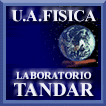|
Resumenes de las Presentaciones Murales
Electronic transport in Co-Ag based multilayered granular alloys
J. Milano1,2, A.M. Llois1,2 and L.B. Steren3
1
Departamento de Física, Lab. TANDAR, CNEA. Av. Gral. Paz 1499 - (1650) Gral. San Martín, Argentina.
2
Departamento de Física, FCEyN, UBA. Pab. I, Ciudad Universitaria - (1429) Buenos Aires, Argentina.
3
Centro Atómico Bariloche and Instituto Balseiro - (8400) San Carlos de Bariloche, Argentina.
Abstract
|
Granular magnetic materials composed of nanocrystalline clusters of ferromagnetic elements embedded
in a noble metal matrix have been extensively studied in the last years. In particular, it has been
experimentally shown that the transport properties are very sensitive to the growth conditions. The
physical reason underlying these effects are related to the shape and size of the clusters which
depend strongly on the sample deposition way. In order to contribute to the comprehension of this
effect, we calculate the electronic transport of multilayered granular alloys, composed of
discontinuous Co layers embedded in Ag alternating with Ag layers. The electronic transport when
the Co clusters percolate is also studied. We focus our attention on the two possible geometries of
the conductivity: CIP (current parallel to the Co layers) and CPP (current perpendicular to the
ones) and their dependence on the cluster's size. The electronic structure is selfconsistently
calculated using a tight binding hamiltonian which includes a Hubbard term within the unrestricted
Hartree Fock approximation. On the other hand, the conductivity tensor is obtained by using the
semiclassical Boltzmann equation in the relaxation time approximation. We show that the
conductivity decreases when the cluster's size becomes larger, but that it increases when the
percolation situation is reached as it is experimentally observed.
contact:<milano@cnea.gov.ar>
|
|
